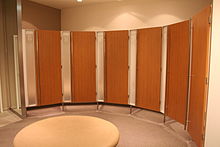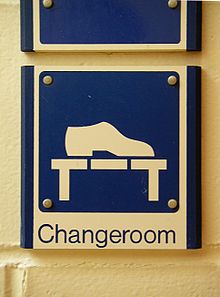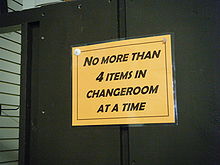- Changing room
-
For other uses, see Changing room (disambiguation)."Locker room" redirects here. For the Canadian television show, see The Locker Room.
A changing room, locker room, dressing room (usually in a sports, theater or staff context) or changeroom (regional use) is a room or area designated for changing one's clothes. Changing rooms are provided in a semi-public situation to enable people to change clothes in privacy, either individually or on a gender basis.
Separate changing rooms may be provided for men and women, or there may be a non-gender specific open space with individual cubicles or stalls.[1] Sometimes a person may change their clothes in a toilet cubicle of a washroom. Many changerooms include washrooms and showers. Sometimes a changing room exists as a small portion of a washroom. For example, the men's and women's washrooms in Toronto's Dundas Square (which includes a waterplay area) each include a change area which is a blank counter space at the end of a row of sinks. In this case, the facility is primarily a washroom, and its use as a changeroom is minimal, since only a small percentage of users change into bathing suits.
Larger changing rooms are usually found at public beaches, or other bathing areas, where most of the space is for changing, and minimal washroom space is included. Beach-style changing rooms are often large open rooms with benches against the walls. Some do not have a roof, providing just the barrier necessary to prevent persons outside from seeing in.
Contents
Types of changing rooms
Various types of changing rooms exist.
- Locker rooms are usually gender-specific spaces where clothes are changed and stored in lockers. They are often used for swimming or other sporting purposes. They are open spaces with no stalls.
- Fitting rooms, or dressing rooms, are usually small single-user cubicles where a person may try on clothes. These are often found at retail stores where one would want to try on clothes before purchasing them.
- Green rooms and trap rooms are usually mixed-gender backstage or under-stage changing spaces found at theaters and other similar venues.
Locker rooms
Locker rooms are thus named because they provide lockers for the storage of one's belongings. Alternatively, they may have a locker room attendant who will keep a person's belongings until they come to retrieve them. Locker rooms are usually open spaces where people change together, but there are separate areas, or separate locker rooms, for men and women. Sometimes they are used in swimming complexes.
Locking devices used in locker rooms have traditionally been key or coin lockers, or lockers that are secured with a combination lock. Newer locker rooms may be automated, with robotic machines to store clothes, with such features as a fingerprint scanner to enroll and for later retrieval. Locker rooms in some waterparks use a microchip equipped wristband. The same wristband that unlocks the lockers can be used to purchase food and drinks and other items in the waterpark.
Locker rooms are also used in many middle schools and high schools. Most of them include showers for after Physical Education.
Fitting rooms
Fitting rooms, or "dressing rooms", are rooms where people try on clothes, such as in a department store. The rooms are usually individual rooms in which a person tries on clothes to determine fit before making a purchase. People do not always use the fitting rooms to change, as to change implies to remove one set of clothes and put on another. Sometimes a person chooses to try on clothes over their clothes (such as sweaters or coats), but would still like to do this in private. Thus fitting rooms may be used for changing, or just for fitting without changing.
Rules and conventions
Retail establishments often post rules such as maximum number of items allowed in changing room, e.g. "no more than 4 items allowed in changeroom".
Green rooms
A green room is a room located backstage in a theatre or some such performance space where the actors (musicians, dancers etc.) wait before they go onstage. Named for its traditional green walls; as green is considered to have a calming effect and is meant to bring focus before the performance and calm nerves. Although this is conventional, they are not always green. Green rooms are usually located backstage, but sometimes under the stage, or to the side. When they are located under the stage, they are often also called "trap rooms" because many stage setups, especially for magicians, involve a trap door that goes to a room under the stage. In a magic trick, a performer may drop down into the trap room, through the trap door, onto a padded surface like a mattress, to "disappear" and change into another outfit. Green rooms are usually not separated by gender, because performers often operate as family and help each other change. For example, a husband and wife team of circus performers might need to "rig" each other up with various wiring, cabling, safety harnesses, and the like. Although there are often small gender separated spaces in some green rooms (to meet building codes, etc.), the changing activities of a green room typically spill out into the main area back stage, where there are dressers and stagehands available to assist in the change of outfit.
Cleansing stations
Traditionally, before the advent of modern plumbing, there existed a number of cleansing stations for cleansing one's clothes and body. Cleansing stations were separated by gender, and combined the function of cleaning clothes with cleaning of the body. The closest modern equivalent would be a combination laundromat plus locker room with showers.
During the nineteenth, and early part of the twentieth century, the increase of urbanization caused an increase in the spread of disease. Poor hygiene was determined to be the cause. Since many families did not have practical means to clean themselves or their clothes, public cleansing stations were established for their use.
Store fitting rooms
 A block of clothing store fitting rooms in Denmark
A block of clothing store fitting rooms in Denmark
It appears that the first store fitting rooms appeared with the spread of department stores.[2] Émile Zola noted their existence in his novel Au Bonheur des Dames (1883), and that they were then forbidden to men.[2] Some years later, when Henri Gervex, who painted Jeanne Paquin in 1906, that was no longer the case.[2]
In any case, Buster Keaton worked in one in an American 1928 silent comedy The Cameraman.[2] Since then, they have continued to provide comic scenes in films, for example in the 1995 French film Les Trois Frères.[2]
Changing room security
Because of the privacy afforded by changing rooms, they create a problem in the trade off between security and privacy, wherein it may be possible for crime to be perpetrated by persons using the cover of privacy to sell drugs, or steal clothing from a department store. Some department stores have security cameras in the changing rooms.[3]
Communal changing rooms pose less of a risk of theft than fitting rooms, because there is not total privacy. In particular, the perpetrator of a crime would not know whether or not other users might be undercover police or security guards. Many modern changing rooms often have labyrinth-style entrances that have no door, so that people outside cannot see in, but security can walk in at any time without the sound of an opening door alerting persons inside. Washrooms in which changing clothes is merely a secondary purpose often also have such labyrinth openings. Many washrooms have security cameras in the main area with a view of the sinks and the urinals from a viewing angle that would only show the back of a user. However, when a washroom is located near a fountain, wading pool, or the like, and is likely to be used for changing clothes, some believe that washroom surveillance cameras would be a violation of privacy.
Another security risk present is that of theft. If belongings are left behind, anyone may simply take them, unless they are secured. Lockers exist for this purpose, and operators may post signs waiving responsibility for stolen items.
See also
- Virtual dressing room
References
- ^ Queen Elizabeth Pool, Edmonton, Canada
- ^ a b c d e « Essayer en corps. Sociologie des cabines d'essayage », Thierry Caro, mémoire de fin d'études à l'Institut d'études politiques de Lille, 2004.
- ^ See Phil Patton's article "You don't have to smile", excerpt included in Netcam Privacy Issues for more on security cameras in changerooms
Rooms, spaces, and architectural elements Public areas - Airport lounge
- Auditorium
- Cafeteria
- Classroom
- Changing room / Locker room
- Conference hall
- Doctor's office
- Function hall
- Mailroom
- Library
- Lobby
- Office
- Refectory
- Restroom
- Security
- Waiting room
Passages and spaces Utility and storage - Attic
- Basement
- Box room / Carport
- Cloakroom
- Closet
- Electrical room
- Equipment room
- Furnace room / Boiler room
- Garage
- Janitorial closet
- Laundry room / Utility room
- Mechanical room / floor
- Pantry
- Root cellar
- Semi-basement
- Studio
- Server room
- Wardrobe
- Workshop
- Vault
- Wine cellar
- Wiring closet / Demarcation point
Shared residential rooms Private rooms Great house areas - Ballroom
- Butler's pantry
- Buttery
- Drawing room
- Fainting room
- Great chamber
- Great hall
- Larder
- Long gallery
- Lumber room
- Parlour
- Root cellar
- Salon
- Saucery
- Scullery
- Servants' hall
- Servants' quarters
- Smoking room
- Solar
- Spicery
- Stillroom
- Undercroft
Other areas Architectural elements Related terms - Building
- Furniture
- House
- House plan
- Rooms
Categories:- Toilets
- Bathrooms
- Restrooms
Wikimedia Foundation. 2010.



